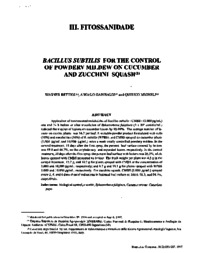Bacillus subtilis for the control of powdery mildew on cucumber and zucchini squash.
Bacillus subtilis for the control of powdery mildew on cucumber and zucchini squash.
Autoria: BETTIOL, W.; GARIBALDI, A.; MIGHELI, Q.
Resumo: Application of concentrated metabolites of Bacillus subtilis - CMBS - (5,000 ug/mL) one and 24 h before or after inoculation of Sphaerotheca fuliginea (3 x 10 4 conidia/mL) reduced the number of lesions on cucumber leaves by 90-99%. The average number of lesions on control plants was 16.7 per leaf. A wettable powder product formulated with cells (10%) and metabolites (10%) of B. subtilis (WPBS), and CMBS sprayed on cucumber plants (1,000 ug/mL and 10,000 ug/mL) twice a week totally controlled powdery mildew. In the control treatment, 18 days after the first spray, the percent leaf surface covered by lesions was 99.0 and 46.7%, on the cotyledonary and expanded leaves, respectively. In the control treatment, 30 days after the first spray, the percent leaf surface with lesions was 26.1%, while leaves sprayed with CMBS presented no lesions. The fresh weight per plant was 4.3 g in the control treatment; 12.2 g, and 10.2 for plants sprayed with CMBS at the concentration of 1,000 and 10,000 ug/mL, respectively; and 9.7 g and 10.1 g for plants sprayed with WPBS 1,000 and 10,000 ug/mL, respectively. For zucchini squash, CMBS (5,000 ug/mL) sprayed every 2,4, and 6 days showed reductions in lesioned leaf surface of 100.0,98.3, and 94,7%, respectively.
Ano de publicação: 1997
Tipo de publicação: Artigo de periódico
Unidade: Embrapa Meio Ambiente
Palavras-chave: Abóbora, Acremonium alternatum, Ampelomyces quisqualis, Cladosporium sp, Controle Biológico, Cucumber, Cucumis Sativus, Cucúrbita Pepo, Fungicidas, Inimigos naturais, Métodos de controle, Oídio, Pepino, Resistance, Resistência, Sphaerotheca fuliginea, Tilletiopsis spp, Verticillium lecanii, Zucchini squash, biological control, control methods, fungicides, natural enemies, powdery mildew
Conteúdo relacionado
Observações
1 - Por padrão são exibidas publicações dos últimos 20 anos. Para encontrar publicações mais antigas, configure o filtro ano de publicação, colocando o ano a partir do qual você deseja encontrar publicações. O filtro está na coluna da esquerda na busca acima.
2 - Para ler algumas publicações da Embrapa (apenas as que estão em formato ePub), é necessário ter, no celular ou computador, um desses softwares gratuitos. Sistemas Android: Google Play Livros; IOS: iBooks; Windows e Linux: software Calibre.
Acesse outras publicações
Acesse a Base de Dados da Pesquisa Agropecuária (BDPA) para consultar o acervo completo das bibliotecas da Embrapa.

